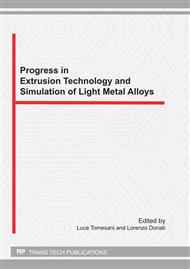p.89
p.97
p.105
p.113
p.121
p.129
p.137
p.145
p.151
Conditions for Sticking Friction between Aluminium Alloy AA6060 and Tool Steel in Hot Forming
Abstract:
The frictional conditions between an aluminium AA6060 alloy and tool steel in hot bulk forming have been investigated. The compressive-rotational method for frictional measurements, presented herein, represents an innovative approach for defining the thermo-mechanical conditions required for sticking friction at the interface between the two metals. Aluminium disks with inserted contrast material were subjected to a variety of pressures and rotated at one end at temperatures ranging from 250 °C to 500 °C. Visual inspection of the surfaces in combination with sectioning of the deformed disks formed a method for studying how different factors affect a stick-slip criterion in metal forming. It was found that the normal contact pressure required for sticking to occur was strongly dependent on the instantaneous temperature. When comparing the normal contact pressure q with the characteristic shear strength k of the aluminium alloy, q/k > 0.6 yielded sticking friction for temperatures above 300 °C, while a ratio of 0.7 was required for the lower temperatures.
Info:
Periodical:
Pages:
121-128
Citation:
Online since:
September 2011
Authors:
Keywords:
Price:
Сopyright:
© 2012 Trans Tech Publications Ltd. All Rights Reserved
Share:
Citation:


